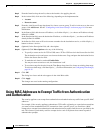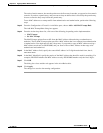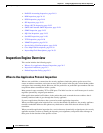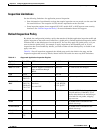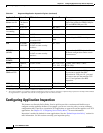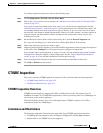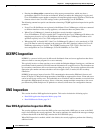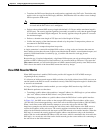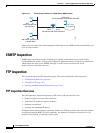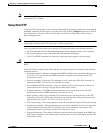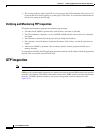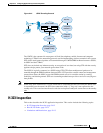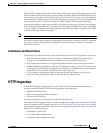
24-6
Cisco ASDM User Guide
OL-16647-01
Chapter 24 Configuring Application Layer Protocol Inspection
DCERPC Inspection
• Entering the debug ctiqbe command may delay message transmission, which may have a
performance impact in a real-time environment. When you enable this debugging or logging and
Cisco IP SoftPhone seems unable to complete call setup through the security appliance, increase the
timeout values in the Cisco TSP settings on the system running Cisco IP SoftPhone.
The following summarizes special considerations when using CTIQBE application inspection in specific
scenarios:
• If two Cisco IP SoftPhones are registered with different Cisco CallManagers, which are connected
to different interfaces of the security appliance, calls between these two phones fails.
• When Cisco CallManager is located on the higher security interface compared to
Cisco IP SoftPhones, if NAT or outside NAT is required for the Cisco CallManager IP address, the
mapping must be static as Cisco IP SoftPhone requires the Cisco CallManager IP address to be
specified explicitly in its Cisco TSP configuration on the PC.
• When using PAT or Outside PAT, if the Cisco CallManager IP address is to be translated, its TCP
port 2748 must be statically mapped to the same port of the PAT (interface) address for Cisco IP
SoftPhone registrations to succeed. The CTIQBE listening port (TCP 2748) is fixed and is not
user-configurable on Cisco CallManager, Cisco IP SoftPhone, or Cisco TSP.
DCERPC Inspection
DCERPC is a protocol widely used by Microsoft distributed client and server applications that allows
software clients to execute programs on a server remotely.
This typically involves a client querying a server called the Endpoint Mapper listening on a well known
port number for the dynamically allocated network information of a required service. The client then sets
up a secondary connection to the server instance providing the service. The security appliance allows the
appropriate port number and network address and also applies NAT, if needed, for the secondary
connection.
DCERPC inspect maps inspect for native TCP communication between the EPM and client on well
known TCP port 135. Map and lookup operations of the EPM are supported for clients. Client and server
can be located in any security zone. The embedded server IP address and Port number are received from
the applicable EPM response messages. Since a client may attempt multiple connections to the server
port returned by EPM, multiple use of pinholes are allowed, which have user configurable timeouts.
DNS Inspection
This section describes DNS application inspection. This section includes the following topics:
• How DNS Application Inspection Works, page 24-6
• How DNS Rewrite Works, page 24-7
How DNS Application Inspection Works
The security appliance tears down the DNS session associated with a DNS query as soon as the DNS
reply is forwarded by the security appliance. The security appliance also monitors the message exchange
to ensure that the ID of the DNS reply matches the ID of the DNS query.
When DNS inspection is enabled, which is the default, the security appliance performs the following
additional tasks:



